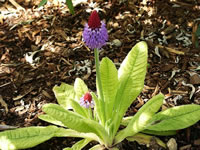How to Grow and Care for Primroses and Primulas
Primula Species and Hybrids
           
Primroses and Primula plants provide you with early spring blooms in almost every color of the rainbow.
Growing Requirements for Primula and Primroses
Most Primula are hardy in USDA zones 5-9
Primroses prefer cool temperatures, rich humus soil with lots of compost and leaf mold added.
Primrose plants appreciate full sun in the spring but they must have partial shade as the summer temperatures warm.
Planting Primroses |

|
Primulas are quite tolerant of being transplanted, even when they are in bloom.
Newly purchased plants can be set into the garden in early spring.
Older plants can be divided and transplanted right after they are finished blooming.
Primroses should be planted in a cool, partly shady area in the garden with rich, well draining, slightly acid soil (pH 6.5).
Primroses must be planted so that their crown is right at soil level and at least six inches apart.
How to Grow Primroses from Seed
Primrose seeds need light for germination, so do not cover them!
The seeds of Primroses are very tiny.
They should be sown in a tray in early spring on a seed bed of moist peat moss which has been layered over sterile potting soil.
The tray must then be chilled in the refrigerator for 3-4 weeks, after which it must be kept at 70 degrees F. during germination, which takes from 3-6 weeks.
|
|
|
A sheet of clear plastic or glass placed over the tray will help to retain the moisture until the seeds sprout
at which time the cover
sheet should be removed.
Transplant the seedlings to individual pots when they are two inches tall.
They will be ready to bloom the following spring.
Growing Primroses as House Plants
Primrose plants can be grown indoors if you are able to provide them with
cool night temperatures of 50-60° F., filtered sun and moist soil.
Daytime temperatures must remain below 80 degrees.
When they have finished blooming in the house it is best to plant them
into the garden, or summer them outdoors in their pots
and moved back into the house at the end of the season.
Species of Primroses
The list of Primrose species and hybrids is extensive, prohibiting me from listing all of them, however here is a list of the most popular types.
Check with your nursery for actual hardiness of available varieties.
|
|
- Japanese Primrose (Primula japonica) (zone 5-9) produces red,
white or purple flowers on stalks which grow up to 40 inches tall. This
variety needs considerable moisture to survive.
- Cowslip Primrose (Primula veris) (hardy) produces 1-2 inch fragrant
yellow flowers in clusters atop 6-12 inch stems. They are well suited
for harsh, cold weather. Cowslips multiply rapidly through self seeding,
and should be divided every other year after they have finished blooming.
- English Primrose (Primula vulgaris) (zone 5-9) are heavy bloomers,
producing 2-3 single flowers on each stalk. They are available in a
wide assortment of colors.
- Polyanthus Primrose (Primula polyanthus) (zone 3-9) are often
erroneously called English Primroses. They are generally all hybrids
of different varieties producing large clusters of flowers atop one
foot stems. They are available in a large variety of colors, and are
well suited to growing in planters. An excellent accent for your bulb
garden or for mass plantings of color. Polyanthus Primroses will often
bloom again in the fall if the plants are cut back to half their size
right after the spring bloom.
- Chinese Primroses (Primula sinensis) (zone 10) are somewhat
tender perennials, and as such are best suited as a potted plant indoors.
The star shaped, white, pink, lavender or coral flowers are clustered
on 8 inch stalks.
- Julianna Primrose (Primula juliae) (zone 5-9) is a group of hybrids
producing some of the earliest bloom. They are low growing and may produce
either singles or clustered flowers.
- Moonlight Primrose (Primula alpicola) (zone 5-9) waits until summer
to show it's fragrant flowers. The blooms are bell shaped on 18 inch
stems, and are usually yellow, however they are sometimes found with
white or purple flowers.
- Fairy Primrose (Primula malacoides) (zones 8-10) produces small
leaves on long stalks and numerous foot tall stalks of flowers.
- German Primrose (primula obconica) (zones 8-10) is a large,
12 inch tall plant with 10 inch round leaves. The 1 inch flowers are
mostly shades of red.
A Gallery of Primroses and Primulas at Cedar Hill
Primroses
 |
 |
|
|
|
Search The Garden Helper:


